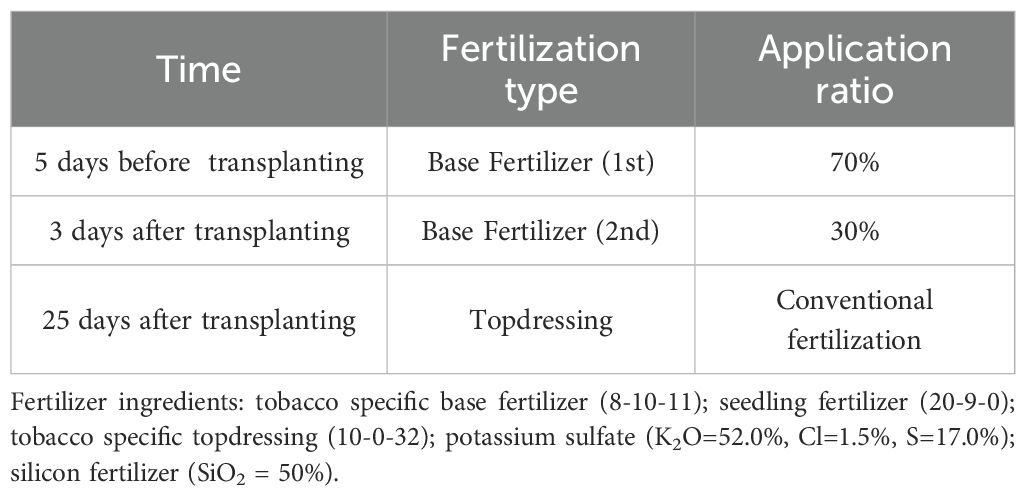- 1College of Resources, Hunan Agricultural University, Changsha, Hunan, China
- 2College of Agriculture, Hunan Agricultural University, Changsha, Hunan, China
Silicon (Si) is widely used in agricultural crop practices. However, the effects of varying Si application rates on tobacco growth and quality remain unclear. Therefore, this study applied four different Si concentrations, i.e., 0, 750, 1500 and 3000 kg/ha of Si (S0, S50, S100 and S200), examined the impact of different Si concentrations on tobacco (Nicotiana tabacum L. ‘Yunyan 87’) growth, nutrient utilization, and economic quality under field conditions. The results demonstrated that Si application significantly improved tobacco growth, the biomass significantly increased by 19.5%-26.53%; during button stage, the plant height significantly increased by 15.38%-19%. Si also enhanced nutrient use efficiency, particularly for nitrogen and potassium. The utilization efficiency of N and K fertilizer were significantly increased by 27.42%-43.71% and 40.25% - 44.63%, respectively. Furthermore, Si improved leaf physical properties, enhancing single-leaf weight and leaf area, while reducing leaf density and midrib ratio, optimizing leaf quality by improving the sugar-alkali ratio and potassium-chloride balance. Notably, the reducing sugar content in upper leaves increased by 15.21% with S50 treatment, while the chlorine content in middle leaves was decreased by 11.11% with S100. Additionally, among all treatments, S50 achieved the highest proportion (94.75%) of medium and high-quality tobacco leaves, along with a 15.70% increase in yield and a 30.76% boost in output value compared to S0. However, excessive Si application (3000 kg/ha) negatively affected quality, increasing nicotine levels and disrupting the sugar-alkali ratio, which elevate leaf irritancy. In conclusion, moderate Si application (750–1500 kg/ha) is an effective strategy for enhancing tobacco yield and quality, offering a sustainable approach to optimize cultivation practices.
1 Introduction
Tobacco (Nicotiana tabacum L.) as a widely cultivated economic crop, is extensively grown in Brazil, China, the United States, and India (Lisuma et al., 2023). As a globally traded crop, tobacco yields and quality is an important indicator of tobacco plant that determines farmers’ income and tobacco market prices (Yan et al., 2025). Therefore, the yield and quality of tobacco leaves deserve special attention.
Silicon (Si), as a beneficial element for plants, is widely used in rice, tomatoes, sugarcane and other high Si demanding crops (Yan et al., 2023; Fan et al., 2018; Verma et al., 2020a). Researchers found that Si promoted the root development of plants, increased photosynthetic efficiency and the dry matter mass, thereby increased yields (Ji et al., 2017). Besides, Si improved the stress resistance of plants, such as salt stress, heavy metal toxicity, drought, high temperature, and ultraviolet radiation (Verma et al., 2023; Verma et al., 2020a; Ghosh et al., 2022; El-Saadony et al., 2022). And Si effectively reduced crop lodging and improved insect resistance by enhancing the mechanical strength such as stems and cell walls, especially under adverse weather conditions (Kumari et al., 2022; Khan et al., 2021; Pavlovic et al., 2021). In addition, the application of Si not only impacted plants, but also had a significant impact on soil physicochemical properties and microbial community structure (Artyszak, 2018). Si application altered the chemical composition of soil minerals by promoting the formation of new clay minerals (Thakral et al., 2024). These clay minerals exhibited a high specific surface area, enabling the adsorption of water, nutrients nitrogen (N), phosphate (P), potassium (K), aluminum (Al), and heavy metals through both physical and chemical mechanisms, which increased soil available Si content, reduced soil heavy metal toxicity, regulated soil pH value, enhanced soil water retention and permeability, thereby improved soil quality, and promoted nutrient use efficiency (Souri et al., 2021; Song et al., 2022; Schaller et al., 2021).
However, it was reported that excessive application of Si may have negative effects, which lower soil pH, leading to soil acidification, and affected soil microbial activity (Schaller et al., 2021). Besides, Si competes with other nutrients such as N, P and K for absorption, and excessive application may lead to nutrient imbalance, affecting normal plant growth (Coskun et al., 2019). Researchers have found that, the demand for Si varies among different plants. For example, rice is a high Si demanding crop with a critical concentration of 30-50g/kg, while the Si critical concentration of tomatoes is 5-8g/kg (Thakral et al., 2024).
In addition, current researches on Si fertilizer predominantly focuses on field crops harvested for seeds and fruits, as well as vegetables, whereas tobacco cultivation primarily targets leaf production (Thakral et al., 2024). However, there is limited research on the effects of Si fertilizer on tobacco. The appropriate application amount of Si fertilizer on tobacco is not clear, and more research is needed to explore the appropriate application amount of Si fertilizer in tobacco agricultural production. Based on this, we conducted field experiments on Nicotiana tabacum L. ‘Yunyan 87’, to investigate the influence of different rate of Si fertilizer on tobacco growth, yields and quality, five experimental treatments were established in this study: CK (without fertilization), S0 (control; conventional fertilization), S50 (application of Si fertilizer at 750 kg/ha), S100 (application of Si fertilizer at 1500 kg/ha), and S200 (application of Si fertilizer at 3000 kg/ha).The agronomic traits, physical characteristics, quality characteristics, yield, output value, average price, nutrient accumulation and fertilizer utilization rate of N, P, K, were assayed in this study. This study to provide a scientific basis for rational Si fertilizer utilization in tobacco cultivation, and practical fertilizer usage guidelines for tobacco farmers to improve tobacco quality and overall market value.
2 Materials and methods
2.1 Experiment design and field location
The tobacco variety (Nicotiana tabacum L. ‘Yunyan 87’) was used in this study, which has good disease resistance, coordinated dehydration and drying, and is easy to bake. The field experiment was conducted in Lanshan County, Yongzhou City, Hunan Province, China (25.18°N, 112.18°E) from March to August 2024. The specific location is shown in Figure 1. The annual average temperature in this area is 18°C to 19 °C, the annual precipitation is 1400 to 1600 millimeters, and the annual sunshine hours are 1400 to 1600 hours. The climate data from March to August, including temperature, precipitation and hydrothermal index are shown in Figure 2. The basic physicochemical properties and the microelement content of the soil (0–20 cm) were as follows: pH, 6.73; organic matter (OM), 65.97 mg/kg; alkali-hydrolysable nitrogen (AN), 229.10 mg/kg; available phosphorus (AP), 102.81 mg/kg; available potassium (AK), 355.85 mg/kg; total nitrogen (TN), 3.64 g/kg; total phosphorus (TP), 2.42 g/kg; total potassium (TK), 6.63 g/kg; chloride ion (Cl-), 5.74 mg/kg; boron (B), 3.69 (mg/kg); available SiO2, 6.98 mg/kg; manganese (Mn), 38.92 mg/kg; iron (Fe), 357.89 mg/kg; nickel (Ni), 3.21mg/kg; copper (Cu), 2.08 mg/kg; zinc (Zn), 9.14 mg/kg.
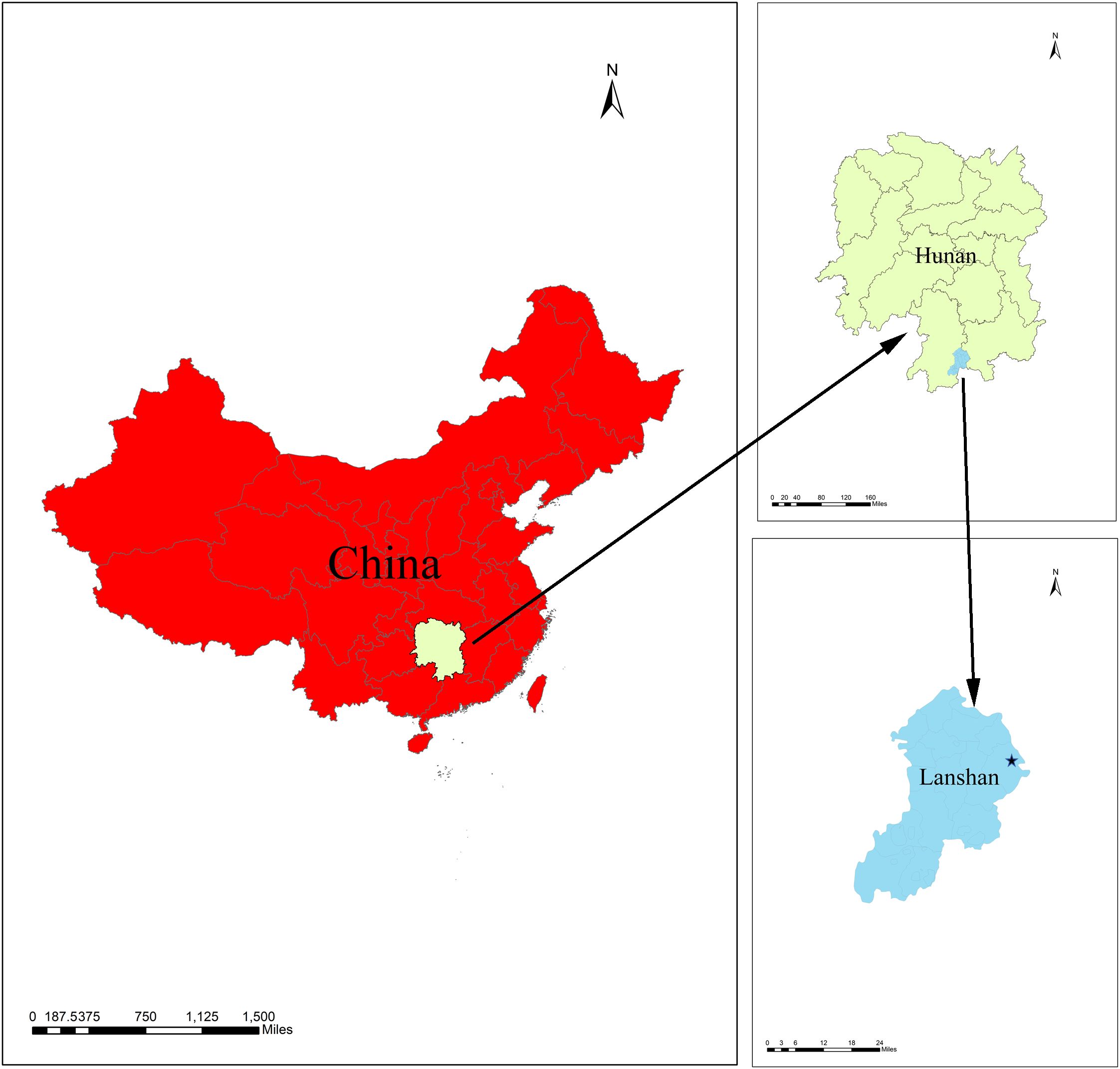
Figure 1. The experimental site location. The pentagram mark in the picture indicates the location of the experimental field.
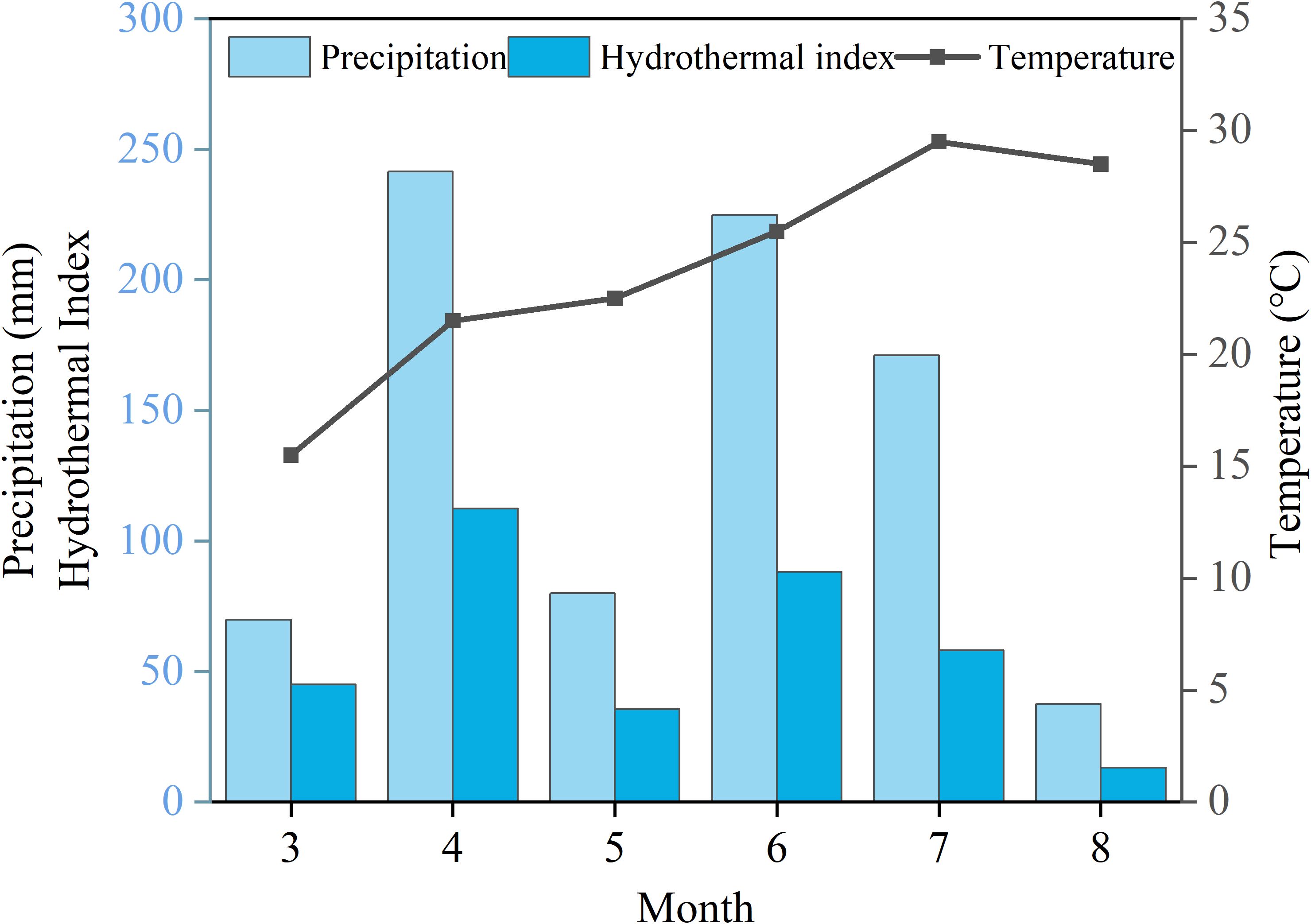
Figure 2. Climate data from March to August. On the left are precipitation and hydrothermal index, and on the right are temperature.
Tobacco was transplanted on March 27, 2024, the lower leaves were harvested on June 26, 2024, the middle leaves were harvested on July 15, 2024, and the upper leaves were harvested on August 1, 2024. The apical part was excised 2–3 weeks prior to floral anthesis, and basal leaf removal was implemented when 30–50% of the central inflorescence had reached bloom stage, ultimately retaining 18 functional leaves per plant through systematic defoliation. In order to ensure the growth and development of plants, high ridge cultivation was adopted during transplantation, covered with plastic film. During the period of plant growth, leaf diseases and leaf eating pests were controlled, and solar insecticidal lamps were installed in the field.
Five experimental treatments were established, CK is no fertilization, S0 is normal fertilization, S50 is normal fertilization+750 kg/ha Si fertilizer, S100 is normal fertilization+1500 kg/ha Si fertilizer and S200 is normal fertilization+3000 kg/ha Si fertilizer. The plant spacing and row spacing are 50 × 120 cm. Three replicates were set up for each treatment, with each replicate area of 4 m × 8.4 m, and each treatment was randomly distributed.
The Si fertilizer used contains SiO2 50%, CaO 12%, MgO 0.7%, Fe2O3 2.3%, organic matter 10%, humic acid 6% and other trace elements 3%. Fertilizer application refers to Table 1. The nutrient input of each treatment was 185.4 kg/ha of N, 127.5 kg/ha of P2O5, and 430.5 kg/ha of K2O.
2.2 Collection of tobacco and soil samples
Soil samples ranging from 0–20 cm were gathered from 10 random sites within each plot on March 15, 2024 and after visible plant residues and stones were removed. The soil samples were air-dried, pulverized, and sieved through 2 mm and 0.0149 mm screens for subsequent analysis, including pH, OM, HN, AP, AK, TN, TP, TK, Cl-, B, available SiO2, Mn, Fe, Ni, Cu, Zn.
At the flower budding stage and button stage of tobacco, 10 plants with consistent growth and no pests or diseases were randomly selected from each plot. The 3rd, 6th, and 9th leaves were selected from top to bottom for SPAD value measurement. Agronomic traits such as plant height (cm), stem circumference (cm), effective leaves (leaves/plant), maximum leaf length (cm), maximum leaf width (cm), and maximum leaf area (cm²) were recorded for each treatment. At the maturating stage of tobacco, the harvested mature tobacco leaves were baked and divided into three parts, including upper leaves (the 1st to 6th leaves), middle leaves (the 7th to 12th leaves), and lower leaves (the 13th to 18th leaves). Physical properties including leaf length (cm), leaf width (cm), leaf area (cm²), single leaf weight (g), density of leaf(g/m2), leaf moisture content (%), leaf midrib proportion (%), thickness (mm) and opening degree (%) were measured. After physical property assessment, economic traits such as yields, output value, and average price, proportion of high-quality tobacco leaves and proportion of medium to high-quality tobacco leaves were evaluated. Then, the tobacco samples were ground into fine powders for chemical composition analysis, including total sugar, reducing sugar, total N, nicotine, K, chlorine, starch, and protein. At the same time, 10 plants with consistent growth and no pests or diseases were randomly selected from each plot. The plants were dug out, cleaned, and divided into five parts: roots, stems, upper leaves, middle leaves, and lower leaves. Biomass and nutrient content for each part were subsequently measured.
2.3 Measurement methods
2.3.1 Soil
The soil samples were measured using the method as described by Schaller et al. (2021) and Islam et al. (2023). In brief, the soil pH was determined using a pH meter (ORION3STAR, Thermo Fisher Scientific, USA) in a 1:25 (w/v) paste with deionized water. OM and AN were quantified using high-temperature potassium dichromate oxidation and the alkaline hydrolysis diffusion method, respectively. AP was extracted using the Olsen method, and readily AK was extracted using the ammonium acetate extraction-flame photometry method. TN was extracted using the Kjeldahl nitrogen determination method, TP was extracted using the acid dissolution molybdenum antimony resistance colorimetric method, TK was extracted using acid dissolution flame photometry method. Trace elements in soil and plant specimens were analyzed using inductively coupled plasma mass spectrometry (ICP-MS, 7800, Agilent Technologies), Cl- using ion chromatography (IC) method (Mishra et al., 2018).
2.3.2 Agronomic traits
The agronomic traits of tobacco were measured according to the Chinese tobacco industry standard YC/T 142-1988.
The leaf area is calculated using the following formula:
2.3.3 Biomass and nutrient content
Tobacco samples was dried at 105°C for half an hour and then dried at 70°C to constant weight to determine the biomass. Roots, stems, and upper leaves, middle leaves, lower leaves were made into analytical samples by grinding with a plant crusher, and then processing through a 0.5 mm plastic sieve.
The N content was determined using a Kjeldahl N analyze (Thilakarathna et al., 2019), the P content was analyzed via the molybdenum-antimony colorimetric method (Zhang et al., 2020), and the K content was measured with an FP640 flame photometer (Artyszak and Gozdowski, 2021).
The nutrient accumulation and fertilizer utilization rate are calculated using the following formula:
2.3.4 SPAD value
The SPAD value of tobacco plants were measured by using the Spad-520 PLUS portable chlorophyll meter.
2.3.5 Economic character
The economic characters of tobacco were calculated according to the national standard (GB2635-92).
2.3.6 Physical properties and chemical composition
The physical properties and chemical composition were measured according to the Chinese tobacco industry standard YC/T 174-2010.
The leaf moisture proportion, opening degree, leaf midrib proportion and density of leaves are calculated using the following formula:
Chemical compositions including total sugar, reducing sugar, total N, nicotine, water-soluble chlorine, starch, and protein were analyzed using an AA3 continuous flow analyzer, while K content was determined by flame spectrophotometry (Ruan et al., 2021).
2.4 Statistical analysis
Microsoft Excel 2019 software was used to sort out data, and they were statistically analyzed using analysis of variance (ANOVA) in SPSS version 22.0 software (IBM, Chicago, USA). The significant difference among treatments was calculated by the least significant difference (LSD) and was considered significant when p< 0.05.
3 Results
3.1 The effect of silicon on tobacco growth and SPAD value
To investigate the impact of different Si fertilizer application rates on the growth of tobacco at different stages, agronomic traits including plant height, stem circumference, effective leaf number, maximum leaf length, and maximum leaf width were measured during the flower bud stage and button stage of tobacco. Results showed that, compared with S0, the plant height of S50, S100, and S200 during the flower bud stage of tobacco significantly increased by 6.05%, 16.57%, and 9.74%, respectively (Table 2). Similarly, during the button stage, this phenomenon also occurred. Compared with S0, the tobacco plant height significantly increased under Si fertilizer treatment, with increases of 15.38%, 16.35%, and 19%, respectively (Table 2). This indicated that Si fertilizer significantly increased the height of tobacco plants. It is worth noting that for tobacco leaves, under Si fertilizer treatment, the maximum leaf length and maximum leaf area of tobacco in the flower bud stage were significantly increased; interestingly, the maximum leaf length of tobacco during the button stage significantly increased by 7.78%, 9.6%, and 6.03%, respectively, while the maximum leaf area was showed the same trend (Table 2). Compared with S0, the maximum leaf width of S200 has significantly increased, with an increase of 7.12% and 15.57% in the flower bud stage and button stage, respectively (Table 2). This indicated that the application of Si fertilizer significantly promoted the growth of tobacco leaves. The effective number of tobacco leaves were increased, with significant increases of 10.20% and 13.33% in S50 and S100 during the bud stage, respectively (Table 2). However, Si fertilizer had no significant effect on the stem circumference of tobacco. In summary, Si fertilizer promotes the growth and development of tobacco leaves and plants.
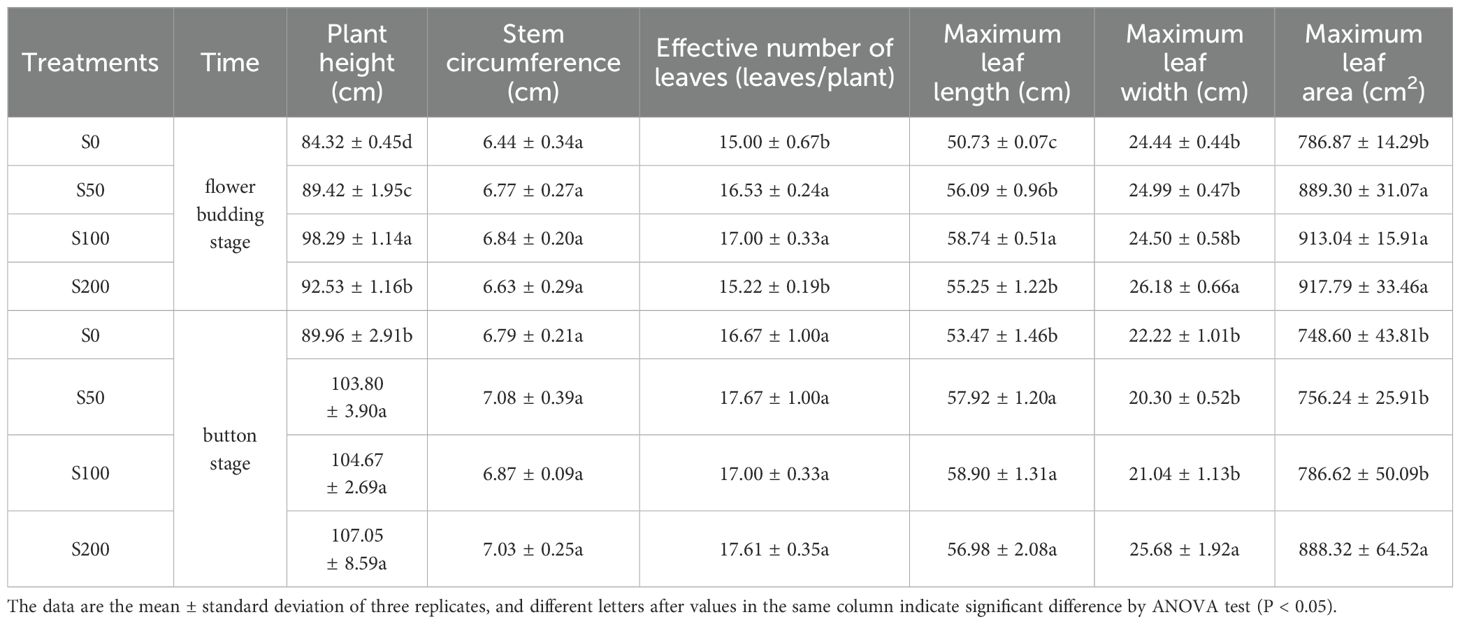
Table 2. The effects of different application rates of silicon fertilizer on the agronomic traits of tobacco.
The SPAD value of tobacco leaves was measured during the bud stage and dome stage. The results indicated that, at the flower bud stage, compared with S0, Si improved the SPAD value of tobacco, and the SPAD value of tobacco leaves in S100 was significantly increased. At the button stage of tobacco, there was no significant difference among the treatments (Figure 3). Collectively, Si was significantly impacted the SPAD value of tobacco in the early stage.
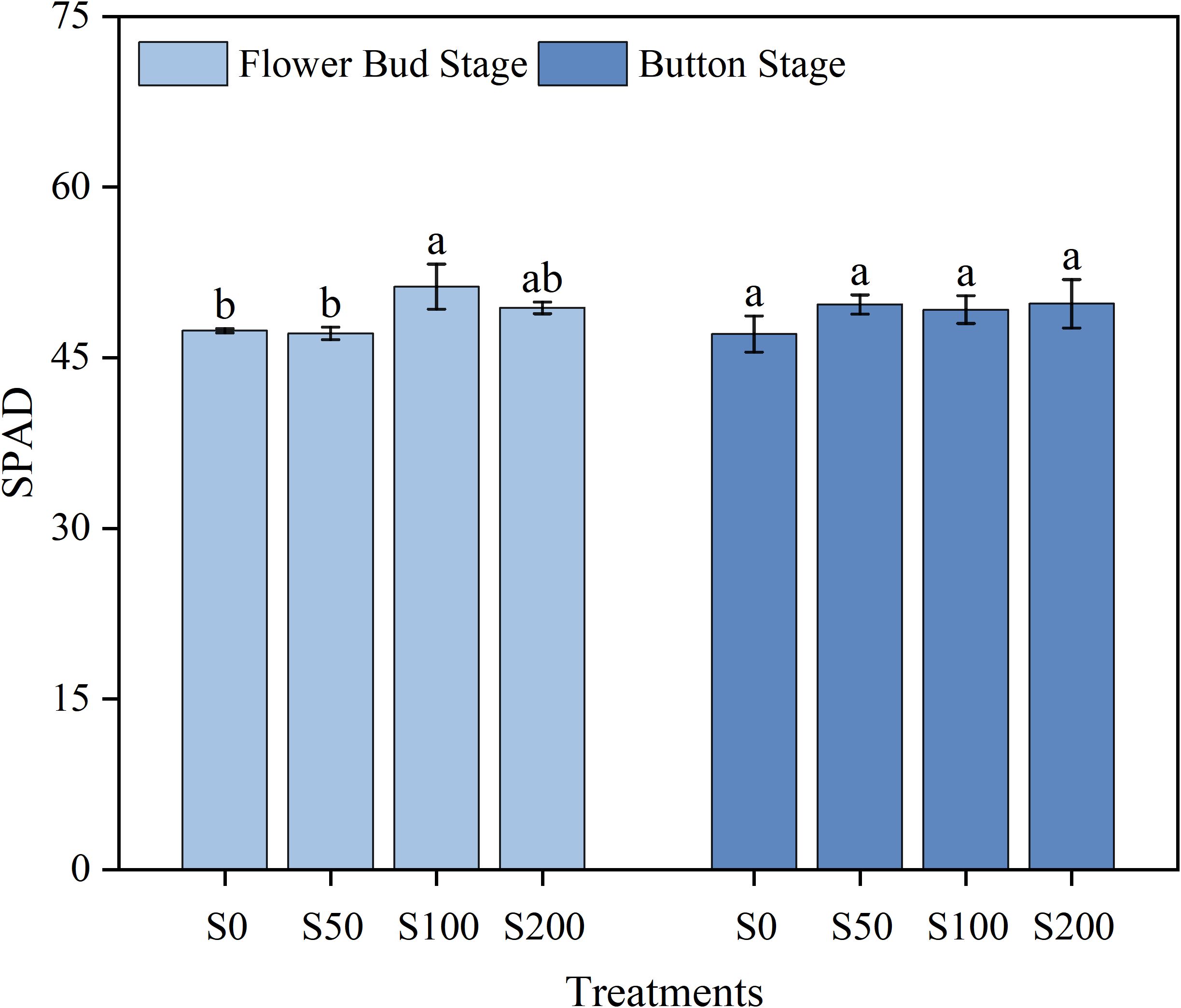
Figure 3. SPAD values in the different treatments. S0, conventional fertilization; S50, apply 750 kg of silicon fertilizer per hectare; S100, apply 1500 kg of silicon fertilizer per hectare; S200, apply 3000 kg of silicon fertilizer per hectare. The analysis of standard error and significant difference in the figure is based on the same variety. Data are means ± SE (n=4). During specific stage of tobacco, the significant difference among treatments is shown by different small letters on the error bars according to the least significant difference test (p< 0.05).
3.2 The effect of silicon on tobacco biomass
During maturating stage of tobacco, the biomass of different parts of tobacco were measured, it indicated that Si fertilizer was significantly increasing the biomass of various parts of tobacco. Compared with the control, Si fertilizer significantly increased the biomass of tobacco plants, with S50, S100, and S200 significantly increasing by 26.53%, 19.95% and 19.50%, respectively (Table 3). Among the upper leaves, lower leaves, stems, and roots of S50 showed the highest growth, increasing by 17.74%, 20.35%, 28.31% and 48.91%, respectively (Table 3). It is interesting that the middle leaves showed the most significant increasing in S200, reaching 55.32g (Table 3). Overall, these results indicated that Si fertilizer significantly increased the biomass of various parts of tobacco.
3.3 The effect of silicon on tobacco nutrient accumulation and fertilizer utilization efficiency
In order to investigate the effect of different Si fertilizer application rates on the nutrient content of tobacco, the accumulation of N, P, and K in various parts of tobacco was measured. These results indicated that compared with S0, the N accumulation in S50, S100 and S200 were increased by 31.14%, 22.16%, and 14.66%, respectively (Figure 4A). However, among Si treatment, the N accumulation of the lower leaves, stems, and roots in S50 showed the most significantly improvement, which were increased by 27.30%, 142.48%, and 50.15%, respectively (Figure 4A). This data indicated that Si was significantly influence the nitrogen content of tobacco, and the application rate of 750kg/ha Si fertilizer has the most significant effect on nitrogen accumulation in tobacco.
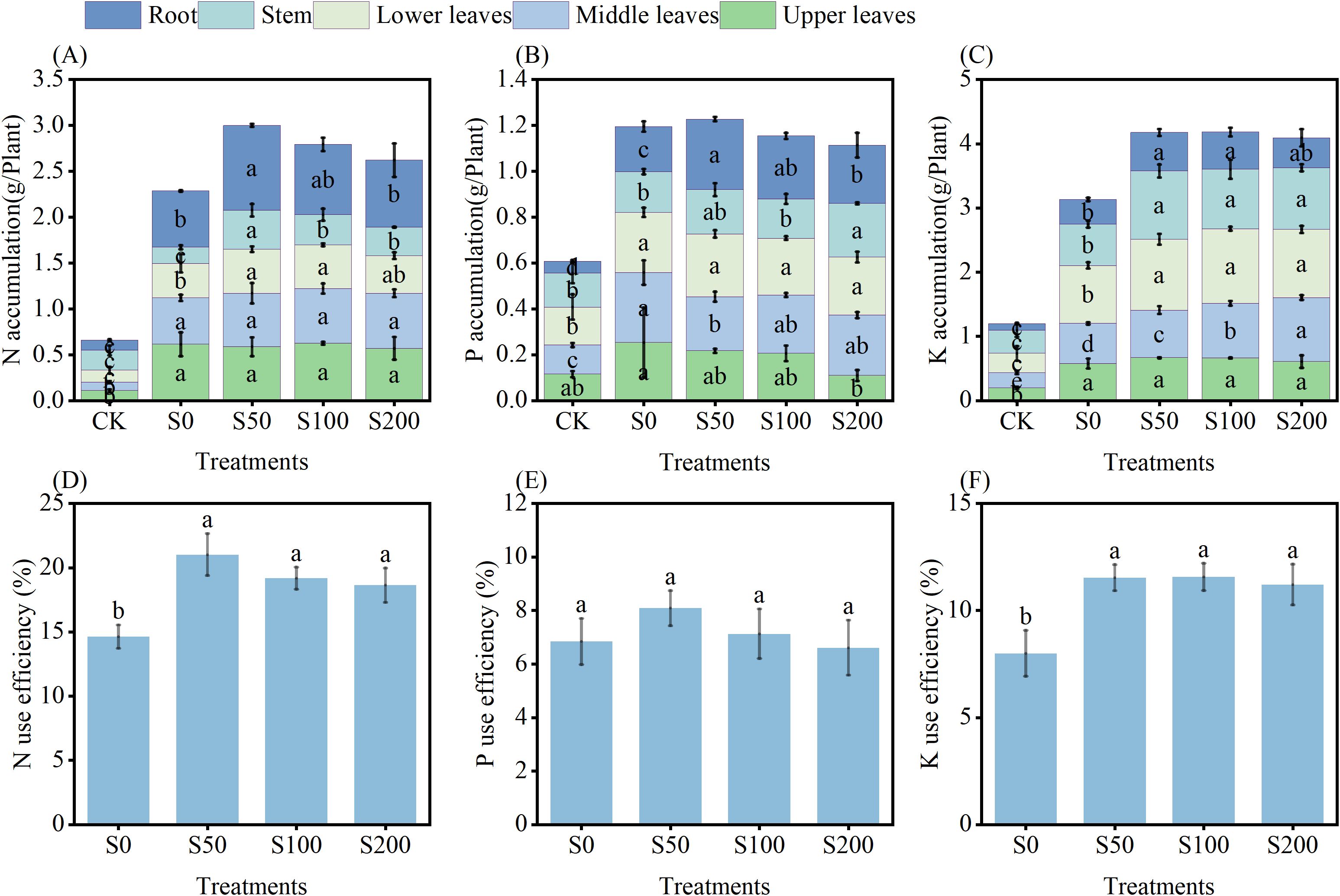
Figure 4. Nutrient accumulation and use efficiency in different treatments. (A) N accumulation; (B) P accumulation; (C) K accumulation; (D) N use efficiency; (E) P use efficiency; (F) K use efficiency. CK, blank, no fertilizer; S0, conventional fertilization; S50, apply 750 kg of silicon fertilizer per hectare; S100, apply 1500 kg of silicon fertilizer per hectare; S200, apply 3000 kg of silicon fertilizer per hectare. The analysis of standard error and significant difference in the figure is based on the same variety. Data are means ± SE (n=4). After specific days of transplantation, the different lowercase letters inside the stacked graph and above the error bar represent significant differences among treatments according to the least significant difference test (LSD; p< 0.05).
Research on tobacco P content found that compared with S0, there was no significant differences in P accumulation of plant and lower leaves in S50, S100, and S200 (Figure 4B). The P accumulation of roots in S50, S100 and S200 were increased by 56.04%, 38.98%, and 29.14%, respectively (Figure 4B). In contrast, the P accumulation of upper leaves of S200 were significantly decreased by 56.72%, while the P accumulation of stem of S200 were significantly increased by 32.13%; and on middle leaves, S50 was significantly decreased by22.66% (Figure 4B). These results indicated that Si fertilizer significantly changed P accumulation content of tobacco.
The application of Si significantly increased the K accumulation in various parts of the tobacco. Compared with S0, the K accumulation in S50, S100 and S200 were significantly increased by 28.08%, 28.30%, and 25.51%, respectively (Figure 4C). Interestingly, the K accumulation of upper leaves in S50, S100 and S200 were no significant difference, the K accumulation of middle leaves in S50, S100 and S200 were significantly increased by 18.86%, 36.18%, and 59.54%, respectively; similarly, the K accumulation of lower leaves and stem were significantly increased (Figure 4C). The K accumulation of roots in S50, S100 were significantly increased by 55.40%, 50.32%, and 20.83%, respectively, reaching0.59 g/plant and 0.58 g/plant (Figure 4C). In summary, the nutrient content of plants was significantly affected by Si fertilizer, and the application rate of moderate Si fertilizer (750–1500 kg/ha) is better.
To explore the impact on the fertilize use efficiency, the utilization efficiency of N, P and K were measured, we found that Si increased the fertilizer use efficiency. Compared to S0, the N use efficiency of S50, S100 and S200 were increased by 43.71%, 31.10%, and 27.42%, respectively (Figure 4D). And the K use efficiency of S50, S100 and S200 were improved by 44.25%, 44.63%, and 40.25%, respectively (Figure 4F). While there was no significant difference among the treatments in P use efficiency (Figure 4E).
3.4 The effect of silicon on tobacco economic characteristics
In order to elucidate the impact of Si on economic characteristics, five indicators including yield, output value, average price, proportion of high-quality tobacco leaves and proportion of medium to high-quality tobacco leaves were studied. The results showed that compared with S0, the yields of S50, S100 and S200 were increased by 15.70%, 13.32%, and 17.00% respectively; similarly, the output values were increased by 30.76%, 23.14%, and 21.39% respectively (Table 4). In addition, the proportion of high-quality tobacco leaves and medium to high-quality tobacco leaves were both the highest in S50, which were 80.11% and 94.75%, respectively, the average price of S50 was significantly increased by 13.08% compared to S0 (Table 4). These results indicated that Si increased the yield and output value of tobacco, improved economic benefits. Furthermore, the effect of moderate Si fertilizer application is better.

Table 4. The effects of different application rates of silicon fertilizer on the economic characteristics of tobacco.
3.5 The effect of silicon on the physical properties of tobacco leaves
In order to study the effect of Si on tobacco quality, the physical properties of the upper, middle, and lower leaves of tobacco were tested, including single leaf weight, density of leaf, leaf moisture proportion, leaf midrib proportion, opening degree, thickness, leaf length, leaf width and leaf area. On upper leaves, compared with S0, the single leaf weight in S50, S100 and S200 were increased by 25.17%, 11.55%, and 10.86%, respectively; and the leaf length of tobacco were significantly increased by 7.99%, 8.84%, and 6.56%, respectively; but the density of leaves was decreased by 6.08%, 9.12%, and 18.80%, respectively, S200 was significantly decreased to 108.42 g/m2 (Table 5). Data showed that Si promoted the growth of upper tobacco leaves, reduce tobacco density, and improved tobacco quality. Compared with S0, the leaf midrib proportion in S50 and S100 were decreased by 10.53% and 2.40%, respectively, while the leaf midrib proportion of S200 was increased by 3.95% (Table 5). This indicate that high application of Si fertilizer actually increased the stem content of upper leaves, which is not conducive to improving the usability of tobacco leaves.
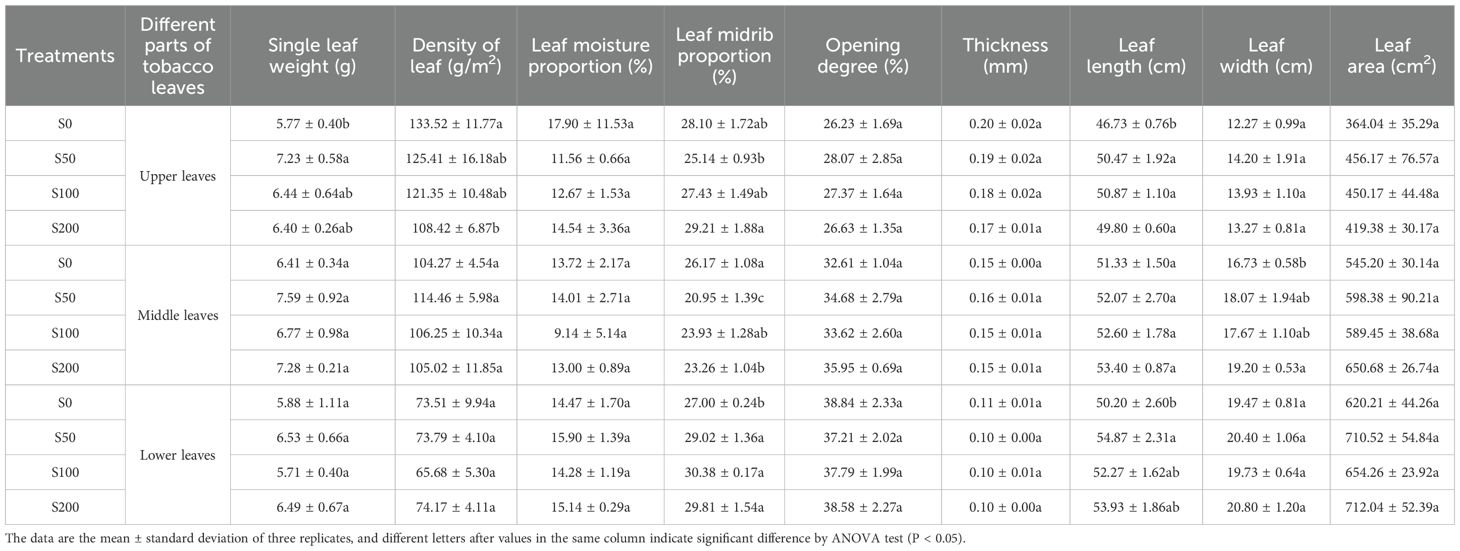
Table 5. The effects of different application rates of silicon fertilizer on the physical properties of tobacco.
On middle leaves, compared with S0, the leaf midrib proportion of S50, S100 and S200 were decreased by 19.96%, 8.58%, and 11.12%, respectively; the leaf width was increased by 7.97%, 5.58%, and 14.74%, respectively, S200 was significantly increased to 19.20 cm; similarly, the leaf area was increased by 9.75%, 8.12%, and 19.35%, respectively (Table 5). This indicates that Si can promote the growth of tobacco leaves in the middle, reduce the stem content of tobacco leaves, and then increase yield.
The lower leaves of tobacco were impacted by Si. On lower leaves, compared with S0, the leaf midrib proportion of S50, S100 and S200 were increased by 7.48%, 12.50%, and 10.40%, respectively; the leaf length in S50, S100 and S200 were increased by 9.30%, 4.12%, and 7.44%, respectively, S50 was significantly increased to 54.87 cm; the leaf area in S50, S100 and S200 were increased by 14.56%, 5.49%, and 14.81%, respectively (Table 5). In summary, Si affected the physical properties of tobacco leaves, promoted the growth of tobacco leaves, and increased the availability of upper and middle leaves. However, high usage of Si fertilizer actually increased the leaf midrib proportion.
3.6 The effect of silicon on the chemical composition of tobacco leaves
Similarly, in order to investigate the effect of Si on the quality of tobacco, chemical indicators of tobacco leaf from different parts were tested. The results indicate that Si fertilizer improved the applicability of tobacco leaves. On the upper leaves, compared with S0, the content of reducing sugar in S50 was significantly increased by 15.21%, while S100 and S200 were significantly decreased by 13.92% and 21.93%, respectively; the K content of S50, S100 and S200 were significantly increased by 6.42%, 12.10%, and 11.56%, respectively; the chlorine content and the ratio of reducing sugar to total sugar of S50 were significantly increased by 20.44% and 19.09%, respectively; the nicotine content of S200 was significantly increased by 13.99%; while the total sugar, starch content and the ratio of total sugar to nicotine of S200 were significantly decreased by 14.29%, 12.05%, and 24.42%, respectively (Table 6). On the middle leaves, compared with S0, the K content of S100 and S200 were significantly increased by 21.60% and 24.40%, respectively; the nicotine of S50 was significantly increased by 18.56%, the chlorine content of S100 was significantly decreased by 11.79%; the total sugar, chlorine content and the ratio of K content to chlorine content of S200 were significantly increased by 15.50%, 26.72%, and 38.35%, respectively (Table 6). On the lower leaves, compared with S0, the K content of S100 was significant increased by 8.86%; the chlorine content of S50, S100 and S200 were significantly reduced by 22.25%, 18.57%, and 20.44%, respectively; the ratio of K content to chlorine content of S50, S100 and S200 were increased by 30.56%, 33.29% and 33.15% respectively; the reducing sugar content and the ratio of reducing sugar to total sugar of S50 were significantly increased by 23.96% and 15.05%, respectively; while the starch content of S50 was significantly decreased by 18.98%; the ratio of total sugar to nicotine of S100 was decreased by 7.52%; the N content of S200 was significantly decreased by 15.26%, while the starch content of S200 was significantly increased by 15.14% (Table 6).
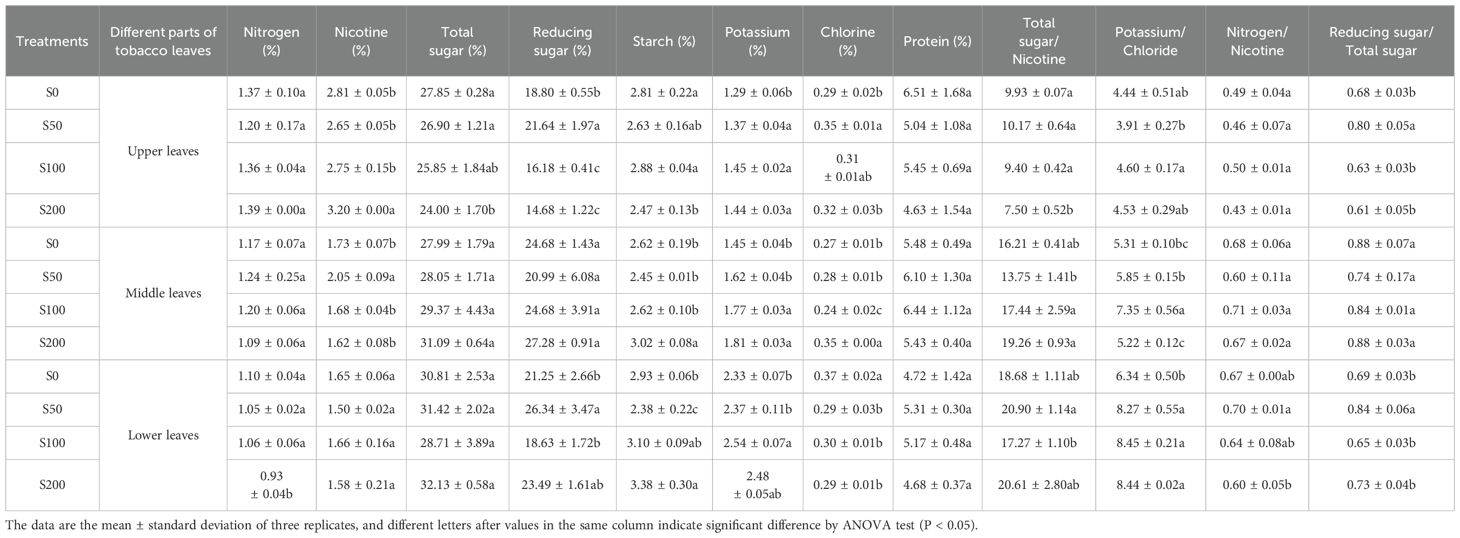
Table 6. The effect of different application rates of silicon fertilizer on the chemical composition of tobacco.
4 Discussion
4.1 Tobacco growth
Chlorophyll, as an essential pigment for photosynthesis, directly affects leaf photosynthetic capacity and organic matter accumulation (Zhang et al., 2018). Studies indicated that SPAD values were positively correlated with chlorophyll content and dry matter accumulation (Condorelli et al., 2018). Marxen et al. (2016) demonstrated that Si enhanced light interaction in plants. Researchers showed that Si application in rice and maize increased the maximum leaf area, aboveground dry matter weight and yields (Pati et al., 2016; Biswal et al., 2024.). In this study, the plant height and maximum leaf area of tobacco were increased under silicon treatment (Table 2).
This study confirmed that Si fertilizer treatment significantly increased the SPAD values and biomass of tobacco (Figure 3; Table 3). At the flower bud stage, the S100 exhibited significantly higher SPAD values than other treatments, although no significant differences were observed among the remaining treatments, their SPAD values remained numerically higher than S0 (Figure 3). That indicated that moderate Si supplementation improved photosynthetic capacity by elevating chlorophyll content, improved tobacco growth, the plants height and leaf area were significantly increased (Huang et al., 2024). This effect may be attributed to silicon’s ability to optimize light utilization through increased leaf conductivity (Verma et al., 2020b). Besides, moderate Si application promoted systemic growth by stimulating root development and nutrient absorption (Parecido et al., 2025). The whole plant biomass in S50, S100 and S200 were significantly increased by 26.53%, 19.95%, and 19.50%, respectively (Table 3). However, at the button stage of tobacco, there was no significant differences in SPAD values, which likely due to natural leaf senescence during later growth stages, which reduced silicon’s chlorophyll synthesis benefits (Luyckx et al., 2017). In addition, excessive application of Si fertilizer may lead to thicker leaves, decreased stomatal conductance, affected CO2 absorption and photosynthetic efficiency, decreased SPAD values, poor root development and stunted plants (Huang et al., 2024). But this phenomenon was not found in this study (Figure 3).
4.2 Nutrient use efficiency
4.2.1 Nitrogen
It demonstrated that the application of Si enhanced N availability, promoted plant N uptake, and N use efficiency (da Silva et al., 2023; Neu et al., 2017). The results of this study were similar (Figure 4A). The application of Si promoted the N metabolism related microorganisms in the soil, thereby improving N availability, which was beneficial for plants to absorb N from the soil (Liang et al., 2021). Furthermore, Si induces the expression of NO3- transporter in roots, thereby improving N absorption and use efficiency, (Neu et al., 2017; Zou et al., 2018), finally, increased the accumulation of N in plants (Figure 4A). Similarly, in this study, the N use efficiency was significantly increased by application of Si (Figure 4D).
4.2.2 Phosphorus
The application of Si fertilizer at a rate of 750 kg/ha increased the P accumulation in tobacco (Figure 4B), similar results was observed in wheat (Triticum aestivum cv. Benchmark) and maize (Gunnarsen et al., 2022). The application of Si fertilizer reduced the soil’s P retention capacity, leading to an increase in the level of water-soluble P thereby increasing the available P content in the soil (Alsaeedi et al., 2019). Researchers found that Si application increased the activity of functional microorganisms and important metabolic enzymes related to P cycling in the soil, thereby promoting P mineralization and improving effectiveness (Liang et al., 2021).
The P content of winter wheat varies with changes in Si supply (Hang et al., 2024). Liang et al. (2021)found that with the increased of Si, the activities of acid phosphatase (AcPA) in soil first increase and then decrease, when the amount of Si added is below a certain threshold, it had a positive impact on plant growth and soil nutrient utilization, however, when the threshold was exceeded, high levels of Si may lead to stress responses that negatively effects on plant growth and soil nutrient utilization. That is similar to this study, with the increase of Si fertilizer application, the P accumulation and P use efficiency were first increased and then decreased (Figures 4B, E). Hu et al. (2018) found that when Si accumulates excessively in plant, it reduces the uptake of P. In this study, the P accumulation was reduced in S100 and S200 treatments, and the P content in the middle leaves of S200 treatment was significantly lower than that S0 (Figure 4B). This phenomenon may be attributed to two distinct mechanisms: (1) Si reduces P uptake by downregulating the expression of the P transporter gene (Hu et al., 2018), (2) excessive Si reduces P availability in the soil (Schaller et al., 2021).
4.2.3 Potassium
Numerous studies have demonstrated that Si application significantly enhanced K use efficiency and K accumulation in plants (Barreto et al., 2022; Parecido et al., 2025). Consistent with these findings, our study revealed similar trends (Figure 4). Specifically, K use efficiency increased by 44.25% in the S50 compared to the S0 (Figure 4F). This improvement may be attributed to silicon’s role in stabilizing cellular membranes and optimizing K transport channels (Ghosh et al., 2022). On the one hand, Si enhances K uptake by increased of aquaporin gene expression and aquaporin activity in plant tissues; on the other hand, the genes responsible for K transport from root cortical cells to the xylem were activated, thereby improving long-distance K mobilization and facilitating K translocation (Barreto et al., 2022). These synergistic mechanisms collectively explain the observed increase in K content in tobacco leaves following Si fertilizer application.
4.3 Tobacco quality
4.3.1 Physical properties
Si extends leaf growth period and promotes leaf growth by synthesizing cytokinins (Etesami et al., 2021). The study showed that the application of Si fertilizer within 750–1500 kg/ha increased the single leaf weight of tobacco, and then, increased the yields (Tables 4, 5). However, when the application rates reached 3000 kg/ha, negative impact on single leaf weight was observed (Table 5). Moderate Si application promotes cell wall thickening and leaf cell expansion, thereby increasing single-leaf weight in tobacco (Verma et al., 2020b). In contrast, excessive Si induces over-lignification of the cell wall, which restricts cellular enlargement and ultimately reduces leaf biomass (Coskun et al., 2019). Si optimizes the structure of tobacco leaves by reducing the deposition of lignin in the main veins, while excessive Si leads to an increased degree of lignification in the main veins, the leaf midrib proportion of S50 leaves was the lowest, while the leaf midrib proportion of S200 was increased (Kumari et al., 2022; El-Saadony et al., 2022) (Table 5). In addition, excessive Si induced excessive enhancement of stem mechanical strength (Schaller et al., 2021), as evidenced by the increased leaf midrib proportion in the lower leaves of S200 (Table 5).
4.3.2 Chemical composition
In this study, the effects of different amounts of Si fertilizer on different parts of tobacco leaves was vary (Table 6). Si fertilization enhanced sugar conversion, improving leaf sweetness and aroma, whereas excessive application inhibited sugar-degrading enzyme activity, reducing sugar accumulation and conversion efficiency (Luyckx et al., 2017). Our results align with these findings, the upper leaves of S50 exhibited the highest reducing sugar content, correlating with optimal flavor characteristics, while the lower leaves of S200 accumulated more total sugar but displayed reduced conversion efficiency (Table 6). These results responses highlight the different effects of Si application rates on leaf biochemistry.
Luyckx et al. (2017) established that appropriate Si optimizes the sugar-nicotine balance, reducing leaf harshness. Our data confirm this, with S50 achieved an ideal sugar-alkaloid ratio of 10.17 in upper leaves, whereas the 3000 kg/ha application significantly decreased this ratio while increasing nicotine content (Table 6), which potentially exacerbating smoking harshness.
Si suppressed the chloride channels (CLC family), resulted in reduced chlorine levels across Si treatments (S50, S100 and S200) relative to the control (S0) (Kumari et al., 2022). Notably, although S200 displayed marginally elevated K content, but the K-to-chlorine ratio of S100 was the more suitable value (Table 6), which was attributable to excessive Si may lead to chloride ion accumulation due to soil acidification (Schaller et al., 2021). This chemical content shift coincided with decreased protein content in silicon-treated leaves (Table 6), which indicating a metabolic change from N to C assimilation pathways (Huang et al., 2024). Collectively, Si fertilizer affected the quality of tobacco, and moderate Si fertilizer improved the quality of tobacco.
4.4 Economic characteristics
A large number of researchers found that the application of Si increased the yields of corn, cotton, rice and sugarcane (Yan et al., 2021; Li et al., 2018; Sakurai et al., 2015; Verma et al., 2020a). In this study, the application of Si increased the yields of tobacco as well, which mainly due to Si promoted the growth of tobacco and increased its biomass (Table 4). Additionally, moderate Si improved the physical properties and chemical balance of tobacco leaves, thus enhanced industrial usability, and the proportion of medium to high-quality tobacco was increased, besides, the proportion of medium to high-quality tobacco in the S50 treatment reached 94.75%, which increased the average price of tobacco leaves (Table 4). The increase of production and average price which together lead to an increase in output value, which is beneficial for the income of tobacco farmers and the development of the industry. However, excessive investment in Si may weaken this benefit.
5 Conclusion
Our study demonstrated that moderate Si application rates (750–1500 kg/ha) significantly improved tobacco productivity and quality. Si application at 750–1500 kg/ha increased the whole-plant biomass increased by 19.95%-26.53%, nutrient use efficiency was improved 34.83%-41.42%, high-quality leaves proportion was increased by 14.53%-14.71%, economic output value was boosted by 23.14%-30.76%. Among them, the S50 performed the best. However, excessive Si application (3000 kg/ha, S200) increased the leaf midrib proportion in the lower leaves by 10.40% and chemical imbalances was emerged, resulting in reduced of industrial availability. The study underscores the necessity of precision Si management to sustainably optimize tobacco quality, providing a scientific basis for Si fertilizer application in tobacco cultivation with practical guidance significance.
Data availability statement
The original contributions presented in the study are included in the article/supplementary material. Further inquiries can be directed to the corresponding author.
Author contributions
MH: Conceptualization, Data curation, Software, Writing – original draft. QL: Funding acquisition, Project administration, Resources, Writing – review & editing. YM: Formal analysis, Supervision, Writing – review & editing. PZ: Conceptualization, Writing – review & editing. KK: Formal analysis, Supervision, Writing – original draft. BW: Conceptualization, Investigation, Writing – review & editing.
Funding
The author(s) declare that financial support was received for the research and/or publication of this article. This article obtained the funding which supplied by the project: “Research on Key Technologies for Hunan Tobacco Quality Improvement Based on the Brand Demand of ‘He Hua’ Project (HBZY2024A013)”.
Acknowledgments
We are especially grateful to the reviewers and editors for appraising our manuscript.
Conflict of interest
The authors declare that the research was conducted in the absence of any commercial or financial relationships that could be construed as a potential conflict of interest.
Generative AI statement
The author(s) declare that no Generative AI was used in the creation of this manuscript.
Publisher’s note
All claims expressed in this article are solely those of the authors and do not necessarily represent those of their affiliated organizations, or those of the publisher, the editors and the reviewers. Any product that may be evaluated in this article, or claim that may be made by its manufacturer, is not guaranteed or endorsed by the publisher.
References
Alsaeedi, A., El-Ramady, H., Alshaal, T., El-Garawany, M., Elhawat, N., and Al-Otaibi, A. (2019). Silica nanoparticles boost growth and productivity of cucumber under water deficit and salinity stresses by balancing nutrients uptake. Plant Physiol. Biochem. 139, 1–10. doi: 10.1016/j.plaphy.2019.03.008
Artyszak, A. (2018). Effect of silicon fertilization on crop yield quantity and quality—A literature review in Europe. Plants 7, 1–17. doi: 10.3390/plants7030054
Artyszak, A. and Gozdowski, D. (2021). Influence of various forms of foliar application on root yield and technological quality of sugar beet. Agriculture 11, 693. doi: 10.3390/agriculture11080693
Barreto, R. F., Maier, B. R., de Mello Prado, R., de Morais, T. C. B., and Felisberto, G. (2022). Silicon attenuates potassium and sulfur deficiency by increasing nutrient use efficiency in basil plants. Scientia Hortic. 291, 110616. doi: 10.1016/j.scienta.2021.110616
Biswal, B., Kumar, R., Kumar, A., Meena, R. K., Ram, H., Rai, A. K., et al. (2024). Enhancing growth, yield, and nutrient quality of fodder maize through foliar application of ortho silicic acid. Silicon 16, 559–571. doi: 10.1007/s12633-023-02691-1
Condorelli, G. E., Maccaferri, M., Newcomb, M., Andrade-Sanchez, P., White, J. W., French, A. N., et al. (2018). Comparative aerial and ground based high throughput phenoty** for the genetic dissection of NDVI as a proxy for drought adaptive traits in durum wheat. Front. Plant Sci. 9. doi: 10.3389/fpls.2018.00893
Coskun, D., Deshmukh, R., Sonah, H., Menzies, J. G., Reynolds, O., Ma, J. F., et al. (2019). The controversies of silicon's role in plant biology. New Phytol. 221, 67–85. doi: 10.1111/nph.15343
da Silva, A. P. R., da Silva, L. J. R., Deus, A. C. F., Fernandes, D. M., and Büll, L. T. (2023). Silicon application methods influence the nutrient uptake of maize plants in tropical soil. Silicon 15, 7327–7334. doi: 10.1007/s12633-023-02592-3
El-Saadony, M. T., Saad, A. M., Soliman, S. M., Salem, H. M., Desoky, E. S. M., Babalghith, A. O., et al. (2022). Role of nanoparticles in enhancing crop tolerance to abiotic stress: A comprehensive review. Front. Plant Sci. 13. doi: 10.3389/fpls.2022.946717
Etesami, H., Jeong, B. R., and Glick, B. R. (2021). Contribution of arbuscular mycorrhizal fungi, phosphate–solubilizing bacteria, and silicon to P uptake by plant. Front. Plant Sci. 12. doi: 10.3389/fpls.2021.699618
Fan, X. Y., Lin, W. P., Liu, R., Jiang, N. H., and Cai, K. Z. (2018). Physiological response and phenolic metabolism in tomato (Solanum lycopersicum) mediated by silicon under Ralstonia solanacearum infection. J. Integr. Agric. 17, 2160–2171. doi: 10.1016/s2095-3119(18)62036-2
Ghosh, U. K., Islam, M. N., Siddiqui, M. N., Cao, X., and Khan, M. A. R. (2022). Proline, a multifaceted signalling molecule in plant responses to abiotic stress: understanding the physiological mechanisms. Plant Biol. 24, 227–239. doi: 10.1111/plb.13363
Gunnarsen, K. C., Schjoerring, J. K., Gómez-Muñoz, B., de Neergaard, A., and Jensen, L. S. (2022). Can silicon in glacial rock flour enhance phosphorus availability in acidic tropical soil? Plant Soil 477, 241–258. doi: 10.1007/s11104-022-05399-0
Hang, J., Wu, B., Qiu, D., Yang, G., Fang, Z., and Zhang, M. (2024). OsNPF3. 1, a nitrate, abscisic acid and gibberellin transporter gene, is essential for rice tillering and nitrogen utilization efficiency. J. Integr. Agric. 23, 1087–1104. doi: 10.1016/j.jia.2023.04.024
Hu, A. Y., Che, J., Shao, J. F., Yokosho, K., Zhao, X. Q., Shen, R. F., et al. (2018). Silicon accumulated in the shoots results indown-regulation of phosphorus transporter gene expression and decrease of phosphorus uptake in rice. Plant Soil 423, 317–325. doi: 10.1007/s11104-017-3512-6
Huang, Q., Ayyaz, A., Farooq, M. A., Zhang, K., Chen, W., Hannan, F., et al. (2024). Silicon dioxide nanoparticles enhance plant growth, photosynthetic performance, and antioxidants defence machinery through suppressing chromium uptake in Brassica napus L. Environ. pollut. 342, 123013. doi: 10.1016/j.envpol.2023.123013
Islam, M. S., Islam, M. T., Ismail, Z., Islam, A. R. M. T., Khan, R., Hasan, F., et al. (2023). Assessment of trace elements in the long-term banana cultivation field’s soil. Front. Environ. Sci. 11. doi: 10.3389/fenvs.2023.1272840
Ji, X., Liu, S., Juan, H., Bocharnikova, E. A., and Matichenkov, V. V. (2017). Effect of silicon fertilizers on cadmium in rice (Oryza sativa) tissue at tillering stage. Environ. Sci. pollut. Res. 24, 10740–10748. doi: 10.1007/s11356-017-8730-1
Khan, I., Awan, S. A., Rizwan, M., Ali, S., Hassan, M. J., Brestic, M., et al. (2021). Effects of silicon on heavy metal uptake at the soil-plant interphase: A review. Ecotoxicology Environ. Saf. 222, 112510. doi: 10.1016/j.ecoenv.2021.112510
Kumari, V. V., Banerjee, P., Verma, V. C., Sukumaran, S., Chandran, M. A. S., Gopinath, K. A., et al. (2022). Plant nutrition: An effective way to alleviate abiotic stress in agricultural crops. Int. J. Mol. Sci. 23, 8519. doi: 10.3390/ijms23158519
Li, Z., Delvaux, B., Yans, J., Dufour, N., Houben, D., and Cornelis, J. T. (2018). Phytolith-rich biochar increases cotton biomass and silicon-mineralomass in a highly weathered soil. J. Plant Nutri Soil Sci. 181, 537–546. doi: 10.1002/jpln.201800031
Liang, Y., Min, L., Fang, Z., Guo, J., Xie, X., and Xu, C. (2021). How silicon fertilizer improves nitrogen and phosphorus nutrient availability in paddy soil? J. Zhejiang University. Science. B 22, 521. doi: 10.1631/jzus.b2000708
Lisuma, J. B., Semoka, J. M., and Mbwambo, A. F. (2023). Effect of Timing Fertilizer Application on leaf yield and quality of tobacco. Heliyon 9. doi: 10.1016/j.heliyon.2023.e19670
Luyckx, M., Hausman, J. F., Lutts, S., and Guerriero, G. (2017). Silicon and plants: current knowledge and technological perspectives. Front. Plant Sci. 8. doi: 10.3389/fpls.2017.00411
Marxen, A., Klotzbücher, T., Jahn, R., Kaiser, K., Nguyen, V. S., Schmidt, A., et al. (2016). Interaction between silicon cycling and straw decomposition in a silicon deficient rice production system. Plant Soil 398, 153–163. doi: 10.1007/s11104-015-2645-8
Mishra, V. G., Das, M. K., Shah, D. J., Jeyakumar, S., Tomar, B. S., and Ramakumar, K. L. (2018). Simultaneous determination of borate, chloride and molybdate in pyrohydrolysis distillates of plant and soil samples by ion chromatography. J. Chromatogr. A 1532, 144–149. doi: 10.1016/j.chroma.2017.12.003
Neu, S., Schaller, J., and Dudel, E. G. (2017). Silicon availability modifies nutrient use efficiency and content, C: N: P stoichiometry, and productivity of winter wheat (Triticum aestivum L.). Sci. Rep. 7, 40829. doi: 10.1038/srep40829
Parecido, R. J., Soratto, R. P., Perdoná, M. J., and Gitari, H. I. (2025). Soil-and foliar-applied silicon and nitrogen supply affect nutrient uptake, allocation, and stoichiometry in arabica coffee plants. Commun. Soil Sci. Plant Anal. 56, 214–229. doi: 10.1080/00103624.2024.2415929
Pati, S., Pal, B., Badole, S., Hazra, G. C., and Mandal, B. (2016). Effect of silicon fertilization on growth, yield, and nutrient uptake of rice. Commun. Soil Sci. Plant Anal. 47, 284–290. doi: 10.1080/00103624.2015.1122797
Pavlovic, J., Kostic, L., Bosnic, P., Kirkby, E. A., and Nikolic, M. (2021). Interactions of silicon with essential and beneficial elements in plants. Front. Plant Sci. 12. doi: 10.3389/fpls.2021.697592
Ruan, Y. N., Tang, Z., Chen, Z., and Xia, T. (2021). Effects of Combined Application of Chemical Fertilizer and Microbial Fertilizer on the Chemical Components Contents of Flue-Cured Tobacco Leaves. In IOP Conference Series: Earth and Environmental Science 792 (1), 012048. doi: 10.1088/1755-1315/792/1/01 2048
Sakurai, G., Satake, A., Yamaji, N., Mitani-Ueno, N., Yokozawa, M., Feugier, F. G., et al. (2015). In silico simulation modeling reveals the importance of the Casparian strip for efficient silicon uptake in rice roots. Plant Cell Physiol. 56, 631–639. doi: 10.1093/pcp/pcv017
Schaller, J., Puppe, D., Kaczorek, D., Ellerbrock, R., and Sommer, M. (2021). Silicon cycling in soils revisited. Plants 10, 295. doi: 10.3390/plants10020295
Song, P., Xu, D., Yue, J., Ma, Y., Dong, S., and Feng, J. (2022). Recent advances in soil remediation technology for heavy metal contaminated sites: A critical review. Sci. Total Environ. 838, 156417. doi: 10.1016/j.scitotenv.2022.156417
Souri, Z., Khanna, K., Karimi, N., and Ahmad, P. (2021). Silicon and plants: current knowledge and future prospects. J. Plant Growth Regul. 40, 906–925. doi: 10.1007/s00344-020-10172-7
Thakral, V., Raturi, G., Sudhakaran, S., Mandlik, R., Sharma, Y., Shivaraj, S. M., et al. (2024). Silicon, a quasi-essential element: Availability in soil, fertilizer regime, optimum dosage, and uptake in plants. Plant Physiol. Biochem. 208, 108459. doi: 10.1016/j.plaphy.2024.108459
Thilakarathna, M. S., Chapagain, T., Ghimire, B., Pudasaini, R., Tamang, B. B., Gurung, K., et al. (2019). Evaluating the effectiveness of rhizobium inoculants and micronutrients as technologies for Nepalese common bean smallholder farmers in the real-world context of highly variable hillside environments and indigenous farming practices. Agriculture 9, 20. doi: 10.3390/agriculture9010020
Verma, K. K., Liu, X. H., Wu, K. C., Singh, R. K., Song, Q. Q., Malviya, M. K., et al. (2020a). The impact of silicon on photosynthetic and biochemical responses of sugarcane under different soil moisture levels. Silicon 12, 1355–1367. doi: 10.1007/s12633-019-00228-z
Verma, K. K., Song, X. P., Verma, C. L., Huang, H. R., Singh, M., Xu, L., et al. (2023). Mathematical modeling of climate and fluoride effects on sugarcane photosynthesis with silicon nanoparticles. Plant Physiol. Biochem. 204, 108089. doi: 10.1016/j.plaphy.2023.108089
Verma, K. K., Song, X. P., Zeng, Y., Li, D. M., Guo, D. J., Rajput, V. D., et al. (2020b). Characteristics of leaf stomata and their relationship with photosynthesis in Saccharum officinarum under drought and silicon application. ACS omega 5, 24145–24153. doi: 10.1021/acsomega.0c03820
Yan, G., Fan, X., Zheng, W., Gao, Z., Yin, C., Li, T., et al. (2021). Silicon alleviates salt stress-induced potassium deficiency by promoting potassium uptake and translocation in rice (Oryza sativa L.). J. Plant Physiol. 258, 153379. doi: 10.1016/j.jplph.2021.153379
Yan, S., Wang, P., Cai, X., Wang, C., Van Zwieten, L., Wang, H., et al. (2025). Biochar-based fertilizer enhanced tobacco yield and quality by improving soil quality and soil microbial community. Environ. Technol. Innovation 37, 103964. doi: 10.1016/j.eti.2024.103964
Yan, F., Zhang, L., Liu, L., Liu, X., Wang, F., Huang, Z., et al. (2023). Silicon alleviates the stress of 1, 2, 4-trichlorobenzene on rice seedlings. Silicon 15, 7371–7381. doi: 10.1007/s12633-023-02591-4
Zhang, S., Guo, X., Yun, W., Xia, Y., You, Z., and Rillig, M. C. (2020). Arbuscular mycorrhiza contributes to the control of phosphorus loss in paddy fields. Plant Soil 447, 623–636. doi: 10.1007/s11104-019-04394-2
Zhang, T., Hu, Y., Zhang, K., Tian, C., and Guo, J. (2018). Arbuscular mycorrhizal fungi improve plant growth of Ricinus communis by altering photosynthetic properties and increasing pigments under drought and salt stress. Ind. Crops Products 117, 13–19. doi: 10.1016/j.indcrop.2018.02.087
Keywords: silicon, tobacco, growth, nutrient use efficiency, economic benefits
Citation: He M, Li Q, Ma Y, Zhou P, Kang K and Wu B (2025) The positive impact of silicon on the yield and quality of tobacco. Front. Plant Sci. 16:1641798. doi: 10.3389/fpls.2025.1641798
Received: 05 June 2025; Accepted: 14 July 2025;
Published: 04 August 2025.
Edited by:
Alexander Lux, Comenius University, SlovakiaReviewed by:
Krishan K. Verma, Guangxi Academy of Agricultural Sciences, ChinaArkadiusz Artyszak, Warsaw University of Life Sciences, Poland
Copyright © 2025 He, Li, Ma, Zhou, Kang and Wu. This is an open-access article distributed under the terms of the Creative Commons Attribution License (CC BY). The use, distribution or reproduction in other forums is permitted, provided the original author(s) and the copyright owner(s) are credited and that the original publication in this journal is cited, in accordance with accepted academic practice. No use, distribution or reproduction is permitted which does not comply with these terms.
*Correspondence: Qiang Li, enFpYW5nbGlAMTI2LmNvbQ==
 Mengjie He
Mengjie He Qiang Li
Qiang Li Ya Ma2
Ya Ma2